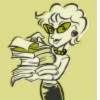 Myers, Walter Dean. 1999. MONSTER. New York, NY: Harper Collins. ISBN 978-0-06-028078-9
Myers, Walter Dean. 1999. MONSTER. New York, NY: Harper Collins. ISBN 978-0-06-028078-9PLOT SUMMARY
Sixteen-year old Steve Harmon is on trial for murder. His part in the crime is said to be that of making sure the coast is clear. Steve didn’t pull the trigger. He didn’t actually do anything, did he? Steve’s life is explored through his thoughts, memories, and conversations. Told from a movie director’s perspective, Steve provides his side of the story. Sparse flash-backs give clues as to what actually happened. However, the reader must decide if the story told is the truth or a movie version of an innocent boy wrongly accused.
CRITICAL ANALYSIS
MONSTER explores the cultures of Harlem and prison. The two settings take turns creating the world in which Steve Harmon lives. While the majority of the voices and characters in the story are likely to be African Americans, ethnicity is not always clear. Walter Dean Myers delves into the cultures of Harlem and prison through the use of language, characterization and setting.
The story begins with a young man in prison. He is frightened by those with whom he shares his cell and those with whom he must interact. He is disgusted by the smells and lack of privacy. In his attempt to deal with his fears, Steve resorts to writing a screenplay about his experiences. “If I didn’t think of the movie I would go crazy. All they talk about in here is hurting people….I hate, hate, hate this place” (p. 45). Prisoners blame their situation on “the man.” They threaten to hurt each other; beating up those who show weakness. In Myers depiction of the Manhattan Detention Center, prison guards are unwilling or unable to stop the violence. In the courthouse guards taunt defendants and defendants taunt each other—thus extending the culture of prison beyond its walls. Nothing in Steve’s past has prepared him or his family for this experience with prison. On visiting day, his father admits, “it just never came to me that you’d ever be in any kind of trouble…” (p. 112).
Harlem, a historically black neighborhood and Steve’s home, is the setting of his flashbacks. Steve is a good student who excels in film class. His father is a college graduate. By all accounts, Steve should be a good kid. Good kids can become associated with a criminal without becoming one, can’t they? Steve associates with young men who see stealing and gang membership as a way of life. While he never overtly accepts these behaviors, neither does he reject them. Through the community members, readers see the neighborhood’s culture including an acceptance of crime. When asked if he was shocked by a murder, one resident replied, “I ain’t shocked. People getting killed and everything and it ain’t right but I ain’t shocked none” (p. 121). The characters are rounded out through language. Use of the word ain’t peppered throughout the dialogue and well-placed examples of Black New York vernacular add to the flavor of Harlem’s culture without confusing the reader.
Myers’ young adult novel, MONSTER, offers a perspective on the culture of prison life as well as the lives of Harlem residents. While these two cultures are certainly not inextricably linked, the reader must see Steve’s life in Harlem in order to fully understand the impact prison has on him and how he got there. Perhaps it is the community’s resignation to senseless murder that places Steve in harm’s way. Perhaps his place of residence—with its poverty and unemployment—places him on the path toward a life of crime. After all, he did not go looking for trouble. In her closing argument, the prosecution declares “if he had chosen priests and Boy Scouts as his companions, I’m sure we wouldn’t be here today” (p. 261). Indeed, would any of us?
REVIEW EXCERPTS
“Balancing courtroom drama and a sordid jailhouse setting with flashbacks to the crime, Myers adeptly allows each character to speak for him or herself, leaving readers to judge for themselves the truthfulness of the defendants, witnesses, lawyers, and, most compellingly, Steve himself.” (Horn Book)
“Myers combines an innovative format, complex moral issues, and an intriguingly sympathetic but flawed protagonist in this cautionary tale of a 16-year-old on trial for felony murder.” (BookList)
Coretta Scott King Award, 2000
National Book Award Finalist, 1999
Michael L. Printz Award, 2000
Reviews obtained from Follett Library Resources and accessed at:
http://www.flr.follett.com/main?SID=b8eed00e8fcf7b8bd35cecbbffabda05
CONNECTIONS
Other books by Walter Dean Myers:
Bad Boy, ISBN 978-0-06-447288-3
The Beast, ISBN 978-0-439-36842-1
The Glory Field, ISBN 978-0-590-45898-6
Malcolm X: A fire burning brightly, ISBN 978-0-06-027708-6
Slam!, ISBN 978-0-590-48668-2
Street Love, ISBN 978-0-06-028080-2

No comments:
Post a Comment